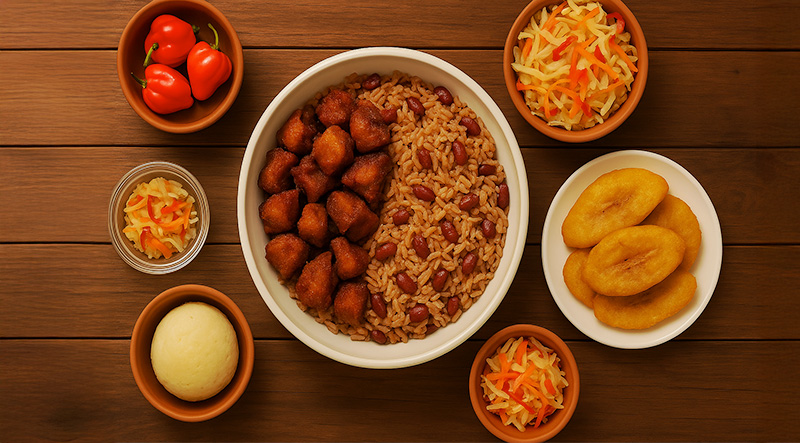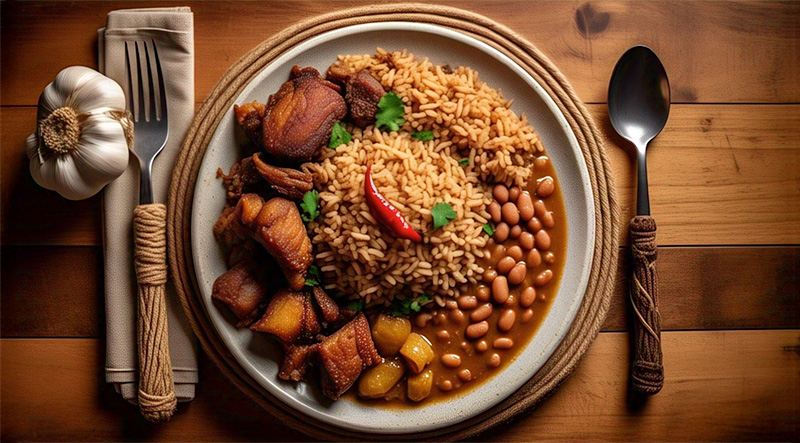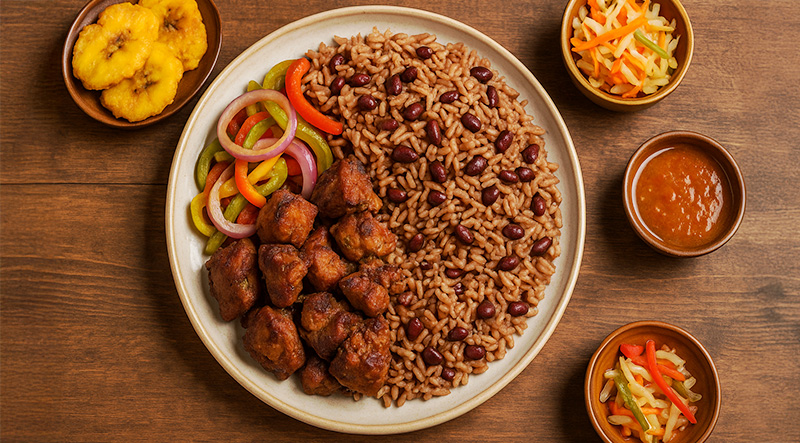Griot with Diri ak Pwa is Haiti's favorite national dish and a veritable feast, crispy, juicy, and bursting with strong Caribbean flavor. Succulent chunks of pork are marinated in aromatic Haitian spices and zesty citrus before being slow-cooked and fried until golden. This dish is the ideal balance of heat, crunch, and comfort when served with Diri ak Pwa, which is made of rich, aromatic rice and beans that are frequently infused with coconut milk, and topped with spicy pikliz, or pickled vegetables. Griot with Diri ak Pwa offers a taste of Haitian pride in every bite, whether it's served at a Sunday family dinner or during a festive gathering. Read More...
The History of Haiti’s National Dish: Griot with Diri ak Pwa:
Griot with Diri ak Pwa is more than just a meal in Haiti—it is a symbol of national pride, cultural heritage, and communal joy. This iconic combination of crispy fried pork and seasoned rice and beans is a staple of Haitian cuisine and has evolved over centuries to become the country’s unofficial culinary ambassador.
African Roots and Culinary Resilience:
The origins of Griot date back to the time of the Transatlantic Slave Trade, when enslaved Africans brought with them rich culinary traditions that adapted to the Caribbean’s tropical landscape. In Haiti, pork became a central part of the diet for the rural population, particularly after independence in 1804, when enslaved people overthrew their colonial rulers and created the world’s first Black republic.
Africans traditionally used citrus, spices, and slow-cooking methods to tenderize tougher cuts of meat. Over time, this developed into the “boil and fry” method that defines Griot today: pork shoulder marinated in epis (a flavorful blend of herbs, peppers, and aromatics), then braised until tender and fried until crisp.
The Rise of Diri ak Pwa:
Diri ak Pwa, or rice and beans, is a staple dish across the Caribbean and Latin America, but in Haiti, it holds special importance as the preferred accompaniment to Griot. Red beans or pigeon peas are typically simmered with garlic, onions, thyme, and often coconut milk before being mixed into rice. The result is a flavorful, hearty base that balances the bold flavors of Griot.
Together, these two dishes represent the unity of Haitian food traditions—hearty, practical, and full of bold character.
From Home Kitchens to National Celebrations:
Historically, Griot with Diri ak Pwa was reserved for special occasions—weddings, holidays, and large gatherings. It is especially popular during Fèt Gede (Day of the Dead celebrations in November), Haitian Independence Day (January 1), and Carnival season. Families often prepare it in large quantities, filling the air with the aroma of citrus, herbs, and sizzling meat.
Today, Griot is served year-round, in homes and Haitian restaurants worldwide. It has come to represent more than just tradition—it embodies resilience, freedom, and flavor.
A Dish That Tells Haiti’s Story:
Griot with Diri ak Pwa is Haiti’s soul food. It tells a story of colonial resistance, culinary adaptation, and cultural pride. From the marination of pork in homemade epis to the final golden fry, and from the coconut-infused rice to the spicy bite of pikliz, this dish brings together Haiti’s past and present in every forkful. It is comfort food with a conscience—a reminder of where Haiti has been and a celebration of where it’s going.
Marinate the Pork:

Cook the Pork:

Fry the Pork:
Prepare the Rice and Beans:

To Serve:
The total preparation and cooking time for Griot with Diri ak Pwa is approximately 3.5 to 4 hours. Preparing the pork includes cutting it into chunks and marinating it with citrus juice, garlic, and epis, which takes about 30 to 45 minutes—though marinating overnight is recommended for deeper flavor. Braising the pork until tender requires about 1.5 to 2 hours, followed by 15–20 minutes of frying until golden brown. Simultaneously, preparing Diri ak Pwa (rice and beans) takes around 45 minutes to 1 hour, including soaking, cooking the beans, and steaming the rice with aromatics and optional coconut milk. Though time-intensive, the result is a richly flavored, comforting Haitian classic worth the effort.
A single serving of Griot with Diri ak Pwa contains approximately 700 to 850 calories, depending on portion size and preparation methods. The fried pork (Griot) provides the majority of the calories, around 450–550 per serving, due to the marbling of pork shoulder and frying oil. The rice and beans (Diri ak Pwa) contribute another 200–250 calories, largely from carbohydrates and some plant-based protein. If coconut milk is used in the rice, that can add an additional 50–100 calories. Condiments like pikliz add minimal calories but offer big flavor without extra fat. Together, the dish is hearty, satisfying, and nutrient-dense, reflective of its traditional roots as a celebratory and communal meal.







